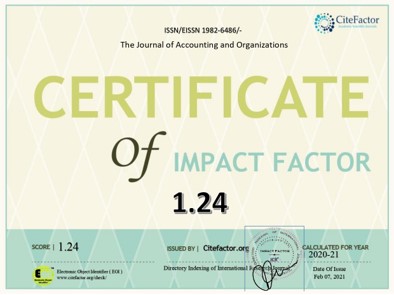Como o volume de negociação reage ao sentimento do investidor?
DOI:
https://doi.org/10.11606/issn.1982-6486.rco.2019.163596Palavras-chave:
Sentimento de investidor, Mercado de ações, Finanças comportamentaisResumo
A economia comportamental ampliou a forma de entender as negociações no mercado de ações. Investidores com diferentes expectativas de otimismo (ou pessimismo) e confiança tendem a negociar de formas distintas no curto e longo prazo. Além disso, seus vieses comportamentais tendem a ser uma das causas subjacentes da não linearidade e da assimetria existente no mercado de ações, fator que dificulta uma análise precisa dessa relação. Por meio de uma abordagem não linear de atrasos distribuídos autorregressivos assimétricos foram analisadas detalhadamente as conexões não lineares e assimétricas de curto e longo prazo entre o sentimento do investidor e o volume de negociação no mercado americano entre 2004 a 2017. Os resultados, além de confirmarem que os vieses comportamentais influenciam o declínio do volume de negócios, indicam que o volume de negociação reage rapidamente à presença de investidores com menor nível de confiança e que essa relação é profundamente assimétrica no longo prazo. A partir destas evidências é presumível que em momentos de baixa liquidez a confiança dos investidores decline e sua aversão ao risco aumente, e por isso diminuam suas negociações para evitar resultados negativos.
Downloads
Referências
Akaike, H. (1973). Maximum likelihood identification of gaussian autoregressive moving average models.
Biometrika, 60, p. 255-265.
Akerlof, G. A., & Shiller, J. S. (2009). Animal spirits: How human psychology drives the economy, and why it
matters for global capitalism. NJ: Princeton University Press.
Baker, M., & Wurgler, J. (2006). Investor sentiment and cross-section of stock return. The Journal of Finance,
61(4), p. 1645-1680. DOI: https://doi.org/10.1111/j.1540-6261.2006.00885.x.
Baker, M., & Wurgler, J. (2007). Investor Sentiment in the Stock Market. Journal of Economic Perspectives,
21(2), p. 129-151. DOI: https://doi.org/10.3386/w13189.
Barberis, N., & Thaler, R. (2002). Survey of behavioral finance. National Bureau of Economic Research, NBER
Working Papers.
Barberis, N., Shleifer, A., & Vishny, R. (1998). A model of investor sentiment. Journal of Financial Economics,
49, p. 307-343.
Beyer, A., & Guttman, I. (2011). The effect of trading volume on analysts' forecast bias. The Accounting Review,
p. 451-481. DOI: https//doi.org/10.2308/accr.00000030.
Boynton, W., Oppenheimer, H., & Reid, S. (2009). Japanese day-of-the-week returns patterns: New results. Global
Finance Journal, p. 1-12.
Brailsford, T. (1996). The empirical relationship between trading volume, returns and volatility. Accounting &
Finance, 36(1), p. 89-111. DOI: https://doi.org/10.1111/j.1467-629X.1996.tb00300.x.
Brown, G., & Cliff, M. (2004). Investor sentiment and the near-term stock market. Journal of Empirical Finance,
11(1), p. 1-27. DOI: https://doi.org/10.1016/j.jempfin.2002.12.001.
Brown, G., & Cliff, M. (2005). Investor Sentiment and Asset Valuation. The Journal of Business, 78(2), p. 405-
440. DOI:https//doi.org/10.1086/427633.
Daniel, K., Hirshleifer, D. A., & Subrahmanyam, A. (1998). Investor Psychology and Security Market Under- and
Overreactions. The Journal of Finance, 53(6), p. 1839-1885. DOI: https://doi.org/10.1111/0022-1082.00077.
Daniel, K., Hirshleifer, D., & Subrahmanyam, A. (2001). Overconfidence, arbitrage, and equilibrium asset pricing.
The Journal of Finance, 56, p. 921-965. DOI: https://doi.org/10.1111/0022-1082.00350.
De Bondt, W., & Thaler, R. (1985). Does the stock market overreact? The Journal of Finance, 40(3), 793-805.
DOI: https//doi.org/10.2307/2327804.
De Long, J., Shleifer, A., Summer, L., & Waldmann, R. (1990). Noise trader risk in financial markets. The Journal
of Political Economy, 98(4), p. 703-738.
Debata, B., Dash, S, R., Mahakud, J. (2018). Investor sentiment and emerging stock market liquidity. Finance
Research Letters, 26, p.15-31. DOI: https://doi.org/10.1016/j.frl.2017.11.006.
Dhaoui, A., & Bacha, S. (2017). Investor emotional biases and trading volume's asymmetric response: A non-
linear ARDL approach tested in S&P500 stock market. Cogent economics & finance, 1(5), p. 1-13. DOI:
https://doi.org/10.1080/23322039.2016.1274225.
Dhaoui, A., Bourouis, S., & Boyacioglu, M. (2013). The impact of investor psychology on stock markets: Evidence
from France. Journal of Academic Research in Economics, p. 35-59.
Dickey, D., & Fuller, W. (1981). Likelihood ratio statistics for autoregressive time series with a unit root.
Econometrica, 49(4), p. 1057-1072.
Ding, D., Charoenwong, K., & Seetoh, R. (2004). Prospect theory, analyst forecasts, and stock returns. Journal of
Multinational Financial Management, 14(4), p. 425-442. DOI: https://doi.org/10.1016/j.mulfin.2004.03.005.
Fama, E. (1965). The behavior of stock-market prices. Journal of Business, 38(1), 34–105.
Fama, E., & French, K. (1988). Permanent and Temporary Components of Stock Prices. The Journal of Political
Economy, 96(2), p. 246-273.
Granger, C., & Yoon, G. (2002). Hidden cointegration. University of California, Working Paper 2002-02.
Grossman, S., & Miller, M. (1988). Liquidity and market structure. The Journal of Finance, p. 617-633.
Ibrahim, M. (2015). Oil and food prices in Malaysia: a nonlinear ARDL analysis. Agricultural and Food Economics,
3(2), 1-14. DOI: https://doi.org/10.1186/s40100-014-0020-3.
Kahneman, D., & Tversky , A. (1979). Prospect theory: an analysis of decision under risk. Econometrica, p. 263-
291.
Kaniel, R., Saar, G., & Titman, S. (2008). Individual investor trading and stock returns. The Journal of Finance,
63, p. 273–310.
Kim, S.-H., & Kim, D. (2014). Investor sentiment from internet message posting and the predictability of stock
returns. Journal of Economic Behavior Organization, 107(B), p. 708-729. DOI: https://doi.org/10.1016/j.
jebo.2014.04.015.
Kumar, A., & Lee, C. (2006). Retail investor sentiment and return comovements. The Journal of Finance, 61, p.
2451–2486.
Kwiatkowski, D., Phillips, P., Schmidt, Y., & Shin, T. (1992). Testing the null hypothesis of stationarity against the
alternative of a unit root. Journal of Econometrics, 54, p. 159-178.
Lee, B., & Rui, O. (2002). The dynamic relationship between stock returns and trading volume: Domestic and
cross-country evidence. Journal of Banking & Finance, 26(1), p. 51-78. DOI: https://doi.org/10.1016/S0378-
4266(00)00173-4.
Lee, C., Shleifer, A., & Thaler, R. (1991). Investor Sentiment and the Closed-End Fund Puzzle. Journal of Finance,
46(1), p. 75-109.
Liu. S. (2015). Investor Sentiment and Stock Market Liquidity. Journal of Behavior Finance, 15(1), p. 51-67. DOI:
https://doi.org/10.1080/15427560.2015.1000334.
Mestel, R., Gurgul, H., & Majdosz, P. (2003). The empirical relationship between stock returns, return volatility
and trading volume an the Australian stock market (Research Paper). University of Graz, Institute of Banking
and Finance, Graz.
Ni, Z., Wang, D., & Xue, W. (2015). Investor sentiment and its nonlinear effect on stock returns - New evidence
from the Chinese stock market based on panel quantile regression model. Economic Modelling, 50, p. 266–
274. DOI: https://doi.org/10.1016/j.econmod.2015.07.007.
Paraboni, A. L., Righi, M. B., Vieira, K. M., & Silveira, V. G. (2018). The Relationship between Sentiment and Risk
in Financial Markets. Brazilian Administration Review, 15(1), p. 1-15. DOI: http://dx.doi.org/10.1590/1807-
7692bar2018170055.
Pesaran, M. H., & Shin, Y. (1999). An autoregressive distributed lag modeling approach to cointegration analysis.
Em S. Strom, Econometrics and Economic Theory in the 20th Century: The Ragnar Frisch Centennial
Symposium. Cambridge: Cambridge University Press.
Pesaran, M. H., Shin, Y., & Smith, R. J. (2001). Bounds testing approaches to the analysis of level relationships.
Journal of Applied Econometrics (16), p. 289–326.
Porteba, J., & Summers, L. (1988). Mean Reversion in Stock Returns: Evidence and Implications. Journal of
Financial Economics, 22(1), p. 27-59.
Romilly, P., Song, H., & Liu, X. (2001). Car ownership and use in Britain: a comparison of the empirical results of
alternative cointegration estimation methods and forecasts. Applied Economics, p. 1803-1818.
Schmeling, M. (2009). Investor sentiment and stock returns: some international evidence. Journal of Empirical
Finance, 16(3), p. 394-408. DOI:https://doi.org/10.1016/j.jempfin.2009.01.002.
Shiller, R. (1981). Do Stock Prices Move Too Much to be Justified by Subsequent Changes in Dividends? The
American Economic Review, p. 421-436.
Shiller, R. J. (2003). From Efficient Markets Theory to Behavioral Finance. The Journal of Economic Perspectives,
17(1), p. 83-104.
Shin, Y., Yu, B., & Greenwood-Nimmo, M. (2014). Modelling asymmetric cointegration and dynamic multipliers
in a nonlinear ARDL framework. Econometric Methods and Applications, p. 281-314. DOI: https://doi.
org/10.1007/978-1-4899-8008-3_9.
Shleifer, A., & Summers, L. (1990). The noise trader approach to finance. Journal of Economic Perspectives, p.
19–33.
Stambaugh, R., Yu, J., & Yuan, Y. (2012). The Short of It: Investor Sentiment and Anomalies. Journal of Financial
Economics, 104(2), p. 288-302. DOI: https://doi.org/10.1016/j.jfineco.2011.12.001.
Ulussever, T., Yumusak, T., & Kar, M. (2011). The day-of-the-week effect in the Saudi stock exchange: a non-
linear garch analysis. Journal of Economics and Social Studies, p. 9-23.
Von Neumann, J., & Morgenstern, O. (1944). Theoru of games and economic behavior. New Jersey: Princeton
University Press.
Yahoo Finance. (2017). Business Finance, Stock Market, Quotes, News. Recuperado de: https://finance.yahoo.
com/ (acesso em 10 de dezembro de 2017).
Yu, J. (2013). A sentiment-based explanation of the forward premium puzzle. Journal of Monetary Economics,
60(4), p. 474–491. DOI: https://doi.org/10.1016/j.jmoneco.2013.04.001.
Yu, J., & Yuan, Y. (2011). Investor sentiment and the mean-variance relation. Journal of Financial Economics,
100(2), p. 367–381. DOI: https://doi.org/10.1016/j.jfineco.2010.10.011.
Zhang, W., & Semmler, W. (2009). Prospect theory for stock markets: Empirical evidence with time-series
data. Journal of Economic Behavior and Organization, 72(3), p. 835–849. DOI: https://doi.org/10.1016/j.
jebo.2009.08.003.
Downloads
Publicado
Edição
Seção
Licença
A RCO adota a política de Acesso Livre (Libre Open Access), sob o acordo padrão Creative Commons (CC BY-NC-ND 4.0). O acordo prevê que:
- A submissão de texto autoriza sua publicação e implica compromisso de que o mesmo material não esteja sendo submetido a outro periódico. O original é considerado definitivo;
- Autores mantêm os direitos autorais e concedem à revista o direito de primeira publicação, com o trabalho simultaneamente licenciado sob a Licença Creative Commons Attributionque permite o compartilhamento do trabalho com reconhecimento da autoria e publicação inicial nesta revista;
- Autores têm autorização para assumir contratos adicionais separadamente, para distribuição não-exclusiva da versão do trabalho publicada nesta revista (ex.: publicar em repositório institucional ou como capítulo de livro), com necessário reconhecimento de autoria e publicação inicial nesta revista;
- Autores têm permissão e são estimulados a publicar e distribuir seu trabalho online (ex.: em repositórios institucionais ou na sua página pessoal) antes ou durante o processo editorial, já que isso pode gerar alterações produtivas, bem como aumentar o impacto e a citação do trabalho publicado (Veja O Efeito do Acesso Livre);
- A revista não paga direitos autorais aos autores dos textos publicados;
- O detentor dos direitos autorais da revista, exceto os já acordados no acordo de Libre Open Access (CC BY-NC-ND 4.0), é o Departamento de Contabilidade da Faculdade de Economia, Administração e Contabilidade de Ribeirão Preto da Universidade de São Paulo.
Não são cobradas taxas de submissão ou de publicação.
São aceitos até 4 autores por artigo. Casos excepcionais devidamente justificados poderão ser analisados pelo Comitê Executivo da RCO. São considerados casos excepcionais: projetos multi-institucionais; manuscritos resultantes da colaboração de grupos de pesquisa; ou que envolvam grandes equipes para coleta de evidências, construção de dados primários e experimentos comparados.
É recomendada a ordem de autoria por contribuição, de cada um dos indivíduos listados como autores, especialmente no desenho e planejamento do projeto de pesquisa, na obtenção ou análise e interpretação de dados e redação. Os autores devem declarar as efetivas contribuições de cada autor, preenchendo a carta ao editor, logo no início da submissão, responsabilizando-se pelas informações dadas.
É permitida a troca de autores durante todo o processo de avaliação e, antes da publicação do manuscrito. Os autores devem indicar a composição e ordem final de autoria no documento assinado por todos os envolvidos no aceite para publicação. Caso a composição e ordem de autoria seja diferente da informada anteriormente no sistema, todos autores anteriormente listados deverão se manifestar favoráveis.
No caso de identificação de autoria sem mérito ou contribuição (ghost, guest or gift authorship), a RCO segue o procedimento recomendado pela COPE.







